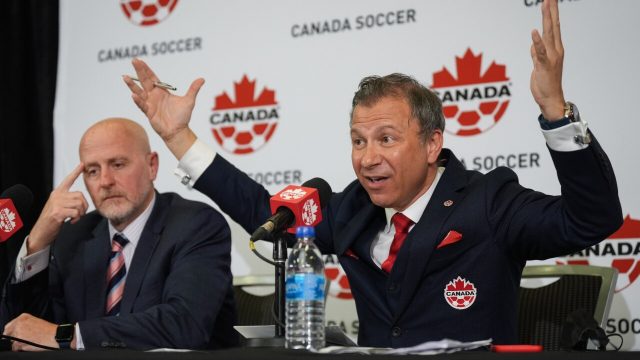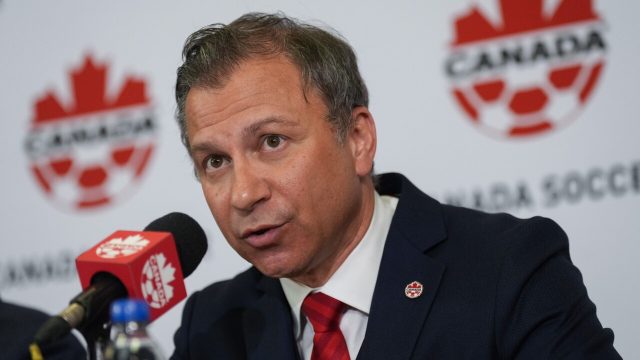
VANCOUVER – Just when all appeared calm in Canadian soccer for a few days, an aftershock hit.
It started with the cancellation of a controversial friendly vs. Iran in Vancouver after Canada Soccer faced heavy criticism for inviting the Iranians onto Canadian soil following the downing of Flight PS752 in 2020 — 85 Canadians were among 176 killed after the airplane was shot down by Iran’s Revolutionary Guard Corps.
As a result, a makeshift match with Panama was arranged for Sunday at BC Place.
And then, in the days leading up to that friendly vs. Panama, the Canadian players refused to train because they are not happy with Canada Soccer and the state of negotiations on a new contract between the sport’s governing body and its players that addresses a variety of issues, including compensation from the prize money that the federation is set to receive for participating in the World Cup in Qatar later this year.
That crescendoed into the players refusing to play in the already hastily planned Panama game, forcing its cancellation about an hour before gates were scheduled to open to the fans.
Thankfully, some progress has been made. After more discussions with Canada Soccer on Sunday, the players returned to training on Monday afternoon at UBC, though a deal hasn’t been struck yet.
How did a program and federation that built up so much goodwill during its scintillating World Cup qualifying run end up here, though? Why are they fighting, and where do they go from here with Nations League matches against Curacao and Honduras on the horizon?
Here is an explainer on the dispute, the hot-button issues at play and a timeline for what’s ahead.

What are the players and federation negotiating?
Talks between the men’s national team players and acting general secretary Earl Cochrane began after the 4-0 win over Jamaica on March 27 at BMO Field in Toronto, the day Canada officially qualified for the World Cup.
On Sunday, the players released a statement via a letter published by TSN’s Rick Westhead that said negotiations had been prolonged “due to executives delaying the process and taking vacations.”
The letter also included a list of asks from the players. Let’s break down some of those demands.
World Cup compensation that includes 40% of prize money and a comprehensive friends and family package for the 2022 World Cup.
Playing at the 2022 World Cup guarantees a healthy chunk of prize money from FIFA for each participating country. The total payout for the Canadians is expected be at least $10 million, although head coach John Herdman told The Athletic that it could be $15 million.
Canada Soccer confirmed it had offered the men’s and women’s national teams 60 per cent of the pot, to be split evenly between the two squads. A source familiar with the negotiations within Canada Soccer told Sportsnet that the players’ ask for 40 per cent of the prize money was a net figure and only covered the men’s portion of the FIFA windfalls. Representatives from the players’ side have not responded to requests to clarify those details.
The request from the Canadian players wasn’t acceptable to Canada Soccer.

“If we as an association only had the men’s team and the women’s team to take care of … we could still not afford this proposal,” Canada Soccer president Nick Bontis said during a press conference on Sunday. “It is untenable as written.”
Bontis also offered some clarity on the negotiations around the travel and ticket package for players’ friends and families to Qatar.
“Their proposal says nothing about tickets. Our proposal back to them says nothing about tickets, so that was actually a new item for our discussion. No problem, we’ll figure out what we can do about tickets but I also want to point out that as of the time we started negotiating, we don’t control tickets. FIFA controls tickets.”
An equitable structure with the women’s national team that shares the same player match fees, percentage of prize money earned at our respective FIFA World Cups and the development of a women’s domestic league.
On Sunday, the women’s team released a statement saying that while they continue to negotiate with Canada Soccer and are “happy” that the men are pushing for an equitable structure, they do not view equal percentages as equal pay.
More former players from the men’s, women’s and para teams integrated into leadership positions within Canada Soccer Board & Organization.
Bontis said there are bylaws stipulating that an alumnus national team player must be on Canada Soccer’s board of directors. As of now, there is just one: Brittany Baxter. However, Bontis confirmed that the board is still undergoing changes, with ex-general secretary Peter Montopoli and former deputy general secretary Joe Guest stepping down at the end of last year and the federation still searching for permanent replacements.
Transparency and a review of the Canadian Soccer Business Agreement.
Apart from splitting World Cup revenues, the crux of these negotiations surrounds Canadian Soccer Business (CSB), launched by the Canadian Premier League to “represent commercial assets and inventory for marquee soccer properties in Canada.”
From its formation in March 2018, CSB has represented all corporate partnerships and broadcast rights for women’s and men’s national teams, on behalf of Canada Soccer. The organization helped facilitate a 10-year rights deal with MediaPro, which launched the OneSoccer streaming service in Canada to broadcast CPL and Canadian national team matches, among other properties.
However, the exact nature of the relationship between Canada Soccer and Canadian Soccer Business is unknown. MediaPro was said to have invested $200 million over the 10 years, while CSB, via CEO Scott Mitchell, said in a statement the business has “invested tens of millions of dollars, and will continue to invest millions more, to benefit Canadian Soccer.”
Steve Reed, Bontis’ predecessor, was Canada Soccer president when MediaPro and CSB became involved.
“We are proud of our agreement with Canada Soccer and what it means to the Canadian soccer ecosystem,” Mitchell said via a statement. “We are prepared to be fully transparent about our agreement which has included an unprecedented amount of revenue to Canada Soccer in the past 18 months in the forms of sponsorship and international media dollars.”
But with Canadian Soccer Business reaching the agreement with MediaPro, there are questions about how MediaPro’s investments are divvied up between CSB, the CPL and Canada Soccer.
Multiple outlets, including Sportsnet, questioned Cochrane and Bontis about CSB’s involvement with the federation and CSB’s share of the broadcasting revenues which was referenced in the players’ letter. Neither official provided a clear response.
“[Broadcasting revenue] is one source of revenue,” Bontis explained. “There are other sources of revenue that we have as well at our disposal, so I don’t want to make a direct link. It’s not accurate to say that this CSB somehow hampers our ability to pay the men. It doesn’t. We’ve offered the men a fair deal and offered the women a fair deal given the financial situation that we’re in and what we predicted that we are going to be in leading up to 2026.”
According to Canada Soccer’s financial statements from 2020 and 2021, revenues increased by more than 50 per cent from 2019 to 2021 — thanks largely to matches being played last year compared to a pandemic-affected 2020. Net assets stood at about $5 million in 2021, up from $3.9 million in 2020.
So what’s next?
Canada faces Curacao at BC Place in its Concacaf Nations League opener on Thursday. Should the protest continue and lead to that match not being played, Concacaf and FIFA could sanction Canada Soccer.
The difference with cancelling friendlies is that payments are made to the affected federations from the responsible party, or Canada Soccer in this case.
That’s why it’s imperative that progress is made so that the players can return to the pitch as soon as possible.




